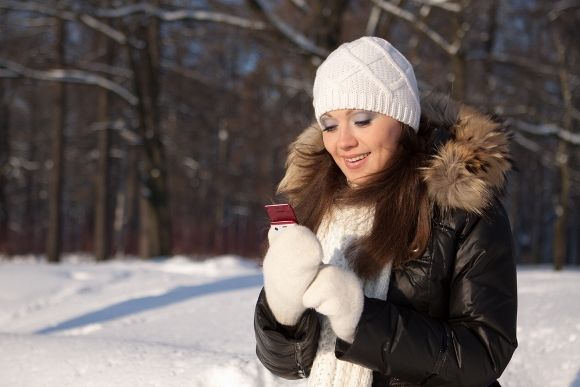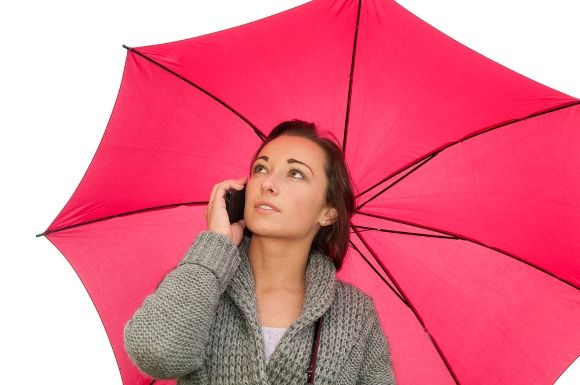Here in my small box room on the North Yorkshire coast in North East England, I regularly witness heavy rain, high winds and icy weather battering the commuters and every day folk as they go about their business. I must admit to a guilty smugness as I watch them scurrying around as I make my 6 foot commute from bedroom to office, knowing that I won’t be buffeted by winds, threatened by ice and snow or drenched by the rain.
Of course, it isn’t always like this. From time to time I have to venture outside and this can mean using my phone, tablet or even (in rare cases) a laptop to get work done while in transit.
Extremes of weather can wreak havoc on digital hardware, so it pays to be aware of just what you need to do to keep using your smartphone on extremely hot days, heavy rain and freezing cold weather.
It’s So Cold!
When you’re freezing in your hat and scarf and need to use your phone, the usual method is to hold the phone in one gloved hand and pull the other glove off with your teeth before dialling a number or messaging someone.
There are several steps to keep in mind when it comes to using a smartphone in cold weather. To start with, keep the device charged up as cold temperatures can cause the battery to run down more quickly. In addition, make sure you have a car charger handy and keep the battery topped up in case you run into trouble on the road.
Drops in temperature can affect the resilience of your device. As such mobile phones, tablets and laptop computers should be handled with care, as bangs and knocks that wouldn’t normally cause issues can result in screen and chassis cracks. If you’re expecting a prolonged period outdoors, keep your phone in an inside pocket where it can be warmed by your body rather than in a backpack or your car.
Of course, if you’re using the new Nokia Lumia 920 Windows Phone, you don’t even need to take your gloves off to use the touchscreen. The Super Sensitive Touch system makes use of a Synaptics ClearPad Series 3 sensor, enabling interaction from gloved fingers, finger nails and even pens. That’s pretty useful, and no doubt something that other manufacturers will be looking to implement in future…
The Rain Is Coming…
One thing that you really need to protect your phone against is the rain. It’s not that the rain can do more damage than anything else (although it can), but more to do with the fact that precipitation is just so common.
While there are solutions to water damage – anything from standard cases and films to the extortionately priced Liquipel – your best recourse is to simply keep your phone out of the rain altogether (this includes hailstones, sleet and snow, too).
If you absolutely must use your phone, however, be prepared by keeping it in a zip-lock plastic bag, complete with a few packets of silica gel. When you need it, take it out of your pocket and use it, but make sure you keep it safe and away from any unnecessary moisture.
My guide to saving a wet cell phone or tablet should tell you everything you need to know about dealing with water issues.
Wow, Scorchio!
Hot weather should mean calling people on your smartphone to make arrangements to meet up – but in extremes of heat, it might mean a phone shutting down of its own accord!
There are various ways of preventing this. To begin with, keep the phone out of direct sunlight, keeping it in the shade and other cool areas. Any area that would be unsuitable for humans is unsuitable for smartphones (Apple recommends that their iPhones should only be used in temperatures between 32 and 95 degrees Fahrenheit and the same can be applied to other devices), and this includes leaving your handset in a car in the hot weather. Battery intensive applications should be shutdown.
Note that there are certain smartphone models that deal with bright sunlight by providing brighter displays that can be used on those wonderfully sunny summer days. Remember to leave your phone for a short time when moving from hot sunlight to a cool interior, allowing it to cool and get closer to room temperature.
Also, don’t forget that the hot weather doesn’t just inspire the more honest members of society to venture outside. Criminals will be an opportunistic threat, so keep your phone close by - and don't forget the water threat of swimming pools and the sea...
Conclusion
Your smartphone probably costs a few hundred dollars to buy new. It’s easy to think of the device as less valuable due to monthly subscription charges, etc., but really given the amount of data that it stores and what it represents in terms of your life, keeping your smartphone safe in adverse weather conditions is extremely important.
Please take the time to give some of the points raised here some thought so that you can deal with the scenarios presented with success, and let us know if you have any ideas or observations about using a smartphone in extreme weather situations.
Image Credit: The beautiful girl with a mobile |The young woman with mobile via Shutterstock | Thanatorn Chusuwan | No Cell Reception via Shutterstock [Broken URL Removed]




